感谢肖为本文提供英文朗读录音,点击上方音频可听。
When I was an undergraduate student in Wuxi of China, I did a part-time job in an art space called Lovere. I saw there was a picture of the famous painting Der Kuss by Gustav Klimt hanging on the wall and I thought it was an imitating painting work. However, the manager told me that was a carpet, a Persian carpet made with pure silk from Iran worth nearly 100,000 CNY, which was the first time I knew about Persian carpets.
我在无锡读本科的时候,曾在那美艺术空间兼职,那儿的墙上挂有一幅世界名画:克里姆特的《吻》。一开始我以为那是一件临摹的绘画作品,结果经理跟我说那是一块挂毯,纯丝的波斯挂毯(或地毯),价值将近10万人民币。这是我第一次知道波斯地毯。
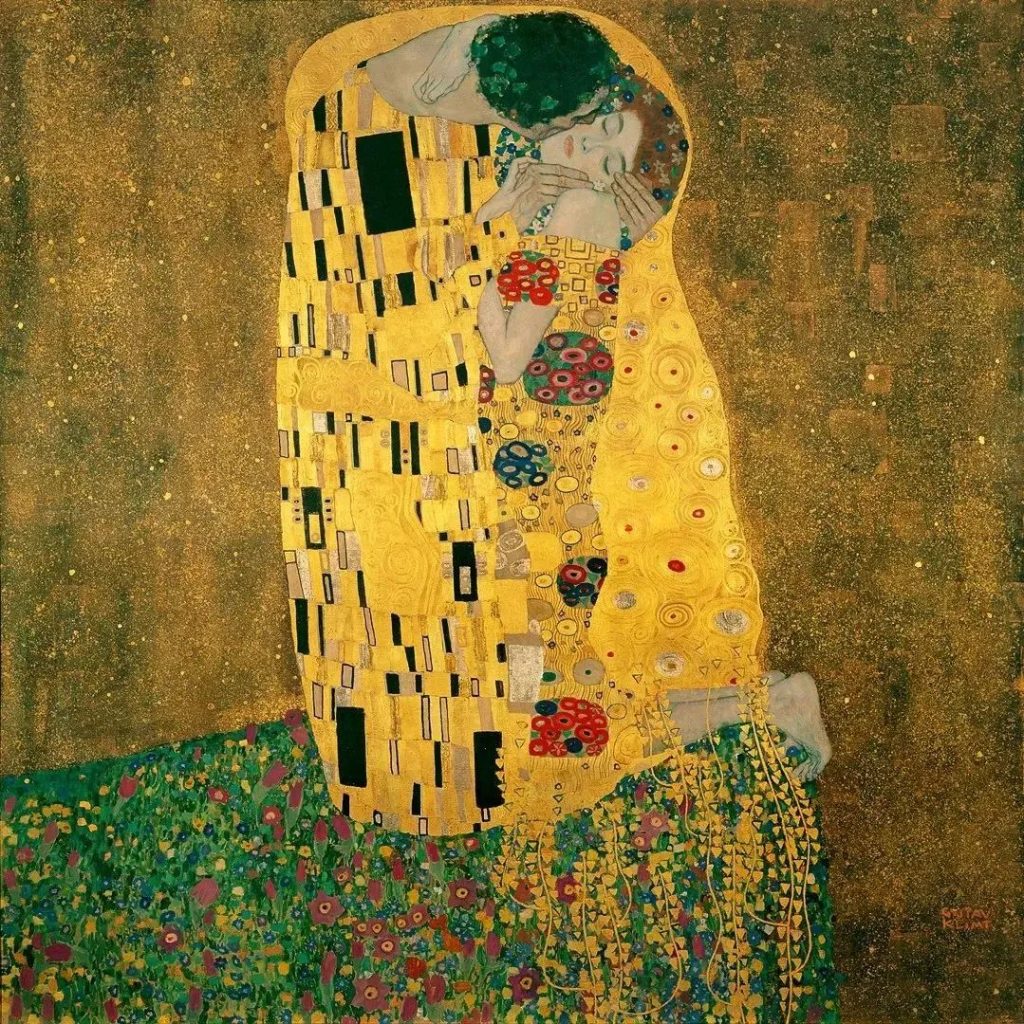
克里姆特的《吻》
Several years later I read a lot about textile history and Persian carpets showed up frequently. It shocked the world for a long time in history and has been shining in the world textile market until today. High-quality carpets or rugs have also been produced in many other countries or regions. However, no carpets outside Iran seem to have surpassed the fame of those produced by Iranian, or Persian.
几年后,我读了很多关于纺织史的内容,波斯地毯频频出现。它们曾一度在历史上震惊世界,至今也依然在世界纺织品市场中熠熠生辉。世界上有许多其它的国家和地区也生产高质量的地毯,但似乎还没有谁超越波斯地毯的盛名。
During the Easter holidays in Europe, I visited Iran with my like-minded friend Jody who is now living in Singapore. I appreciate her accompanying my carpet exploring tour very much. As one of my main expectations to visit Iran was to see local Persian carpets, I kept asking people where we could see carpets and the process of making them since the first day we entered this country.
欧洲复活节假期期间,我和现居新加坡的同道中人晓萌一起去了伊朗旅行。我十分感激她陪我去找波斯地毯。因为我去伊朗旅行的主要目的之一就是看当地的地毯,所以从我们入境这个国家的第一天起,我就一直在问哪里能看到地毯及其制作过程。
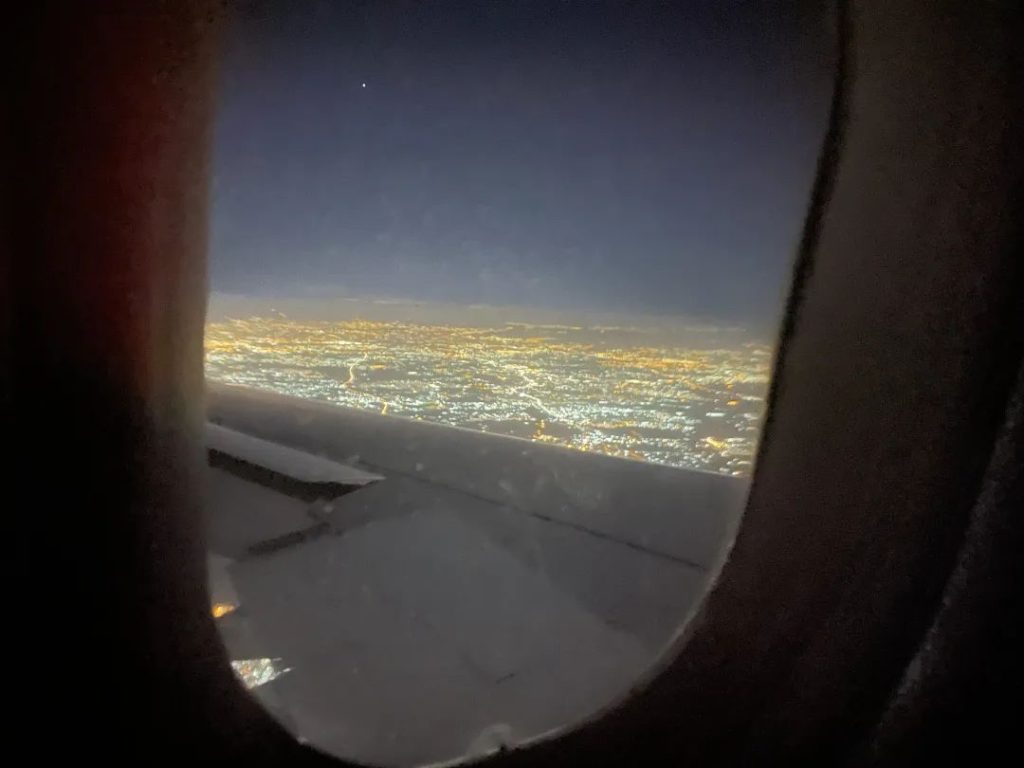
在飞机上初见德黑兰
Actually, before we entered Iran we transferred and met each other in Istanbul, Turkey. We spent one day in Istanbul and saw a lot of carpet stores on the streets. Turkish carpet sellers showed us some of their products and told us, the most delicate and expensive ones among them were all from Iran and one of the ways to distinguish them was to see whether there was a Persian signature woven on the carpet. Every authentic handmade Persian carpet will have the maker’s name at the bottom.
其实,入境伊朗之前,我们都在土耳其的伊斯坦布尔转机,彼此碰面。我们在伊斯坦布尔逗留了一天,在街上看到了很多地毯商店。土耳其的地毯商向我们展示了一些它们的产品,也告诉我们其中最精致也最昂贵的地毯都来自伊朗。判断一块地毯是否为波斯地毯的方法之一,是看上面有没有织入波斯人的名字。每一块真正的波斯手工毯底部都会有制作者的姓名。
Finally, we didn’t manage time to visit the biggest carpet market in Tehran introduced by an Iranian woman, nor the bazaar in Tabriz said to be the best place to see Persian carpet making by an Iranian girl sitting next to me on the plane. However, we met Noah and Ashkan when we were visiting Ali Qapu Palace(Persian: عالی قاپو )on the west side of Naqsh-e Jhan Square (Persian: میدان امام) in Isfahan.
最终我们没安排上时间去看德黑兰最大的地毯市场(一位伊朗女性介绍的),也没能去据说是看波斯地毯制作的最好地方的大不里士集市(入境伊朗的飞机上坐我旁边的伊朗女孩介绍的)。不过,我们在伊斯法罕参观伊玛目广场(波斯语: میدان امام)西侧的阿里卡普宫(波斯语: عالی قاپو)时,遇到了Noah和Ashkan。

伊斯法罕伊玛目广场
In the Ali Qapu Palace, Noah and Ashkan talked with us because foreigners are rarely seen in Iran and we were just interviewed by a group of YouTubers from Tehran. After knowing they are locals living in Isfahan, I asked if they knew where I could see Persian carpets and their making process here.
因为外国人在伊朗非常罕见,我们在阿里卡普宫刚被一群来自德黑兰的油管博主采访,Noah和Ashkan就和我们搭话。得知他们是伊斯法罕本地人之后,我就问他们知不知道哪里能看到波斯地毯及其制作过程。
Soon we left the Palace together because Noah happened to know a friend owning a carpet shop. He himself, is also an amateur in silk braiding. On the way to the carpet place, we knew that Noah is a shop designer and Ashkan graduated from ancient architecture conservation and restoration related to archaeology eight years ago. That’s why we could meet them because Ashkan was investigating ancient structures of the Palace that day.
很快我们就和他们一起离开了阿里卡普宫,因为Noah刚好认识一个朋友是开地毯店的,而他自己也是一个丝绳编织的业余爱好者。在去看地毯的路上,我们得知Noah是一个店铺设计师,而Ashkan八年前从考古学相关的古建保护与修复专业毕业。我们之所以能遇到他们,是因为这天Ashkan在阿里卡普宫调查古建结构。
Before we went to Noah’s friend’s shop, we went to the big bazaar in Naqsh-e Jhan Square. Noah helped us find a workshop inside the bazaar with some craftsmen mending old carpets. Carpets sent here to be fixed or washed were those valuable ones owned by wealthy people in Iran. They are all handmade, usually by famous carpet makers with their names woven on them.
去Noah朋友的地毯店之前,我们去了伊玛目广场的大巴扎(集市),Noah在里面帮我们找到了一个专门修复古旧地毯的作坊。送到这个作坊来进行修复或清洁的地毯,基本都来自伊朗的富裕人家,价值较高。这些地毯都是手工制作,通常出自名家之手,上面也织有制作者的名字。
In the workshop, we met a man professional on mending carpets. He was happy with our visit and glad to show us his work. He cannot speak English or Chinese but we were lucky that Noah and Ashkan translated for us. During our visit, he showed us how he adjusted a curved thread in the ground weave of a carpet to the original straight one, with a special nail and hammer hitting under a benchmark string.
在这个作坊里,我们见到了一个地毯修复专业人士,他非常欢迎我们的到来并很乐意向我们展示他的工作。他不会说英语也不会说中文,但Noah和Ashkan可以帮我们翻译,这让我们感到幸运。在我们参观期间,他为我们演示了他如何将一根在地毯的地组织中弯曲了的纱线校正到原始笔直的状态:用专门的钉子和锤子在基准线下击打校正。

修复中的地毯底面
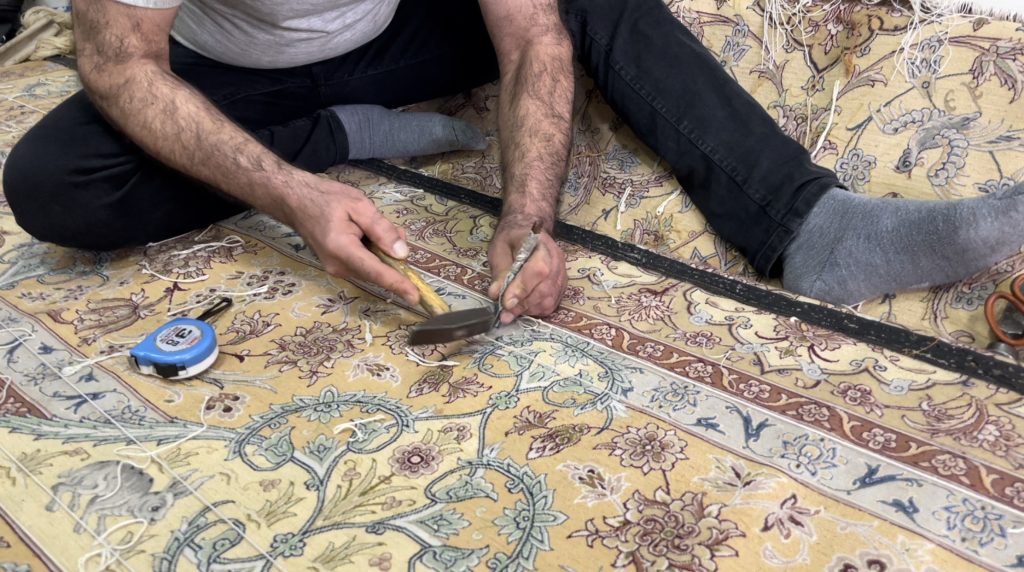
调整地毯中的一根纱线
Then we found a place in the bazaar selling dyed yarns for making carpets. There are also places not far away selling original wool or cotton yarns to be dyed. It seems that carpet production is really a very significant industry in Iran. From carpet shops and carpet-weaving models everywhere, I also got the impression that Iranian people are proud of their carpet culture from the bottom heart.
然后我们又在巴扎里发现了一个卖各色地毯用纱线的地方,不远处也有卖尚未染色的羊毛或棉的原纱的,看起来地毯生产的确是伊朗一个非常重要的产业。从随处可见的地毯商店及地毯编织模型来看,我感觉伊朗人民也打心底里以他们的地毯文化为荣。
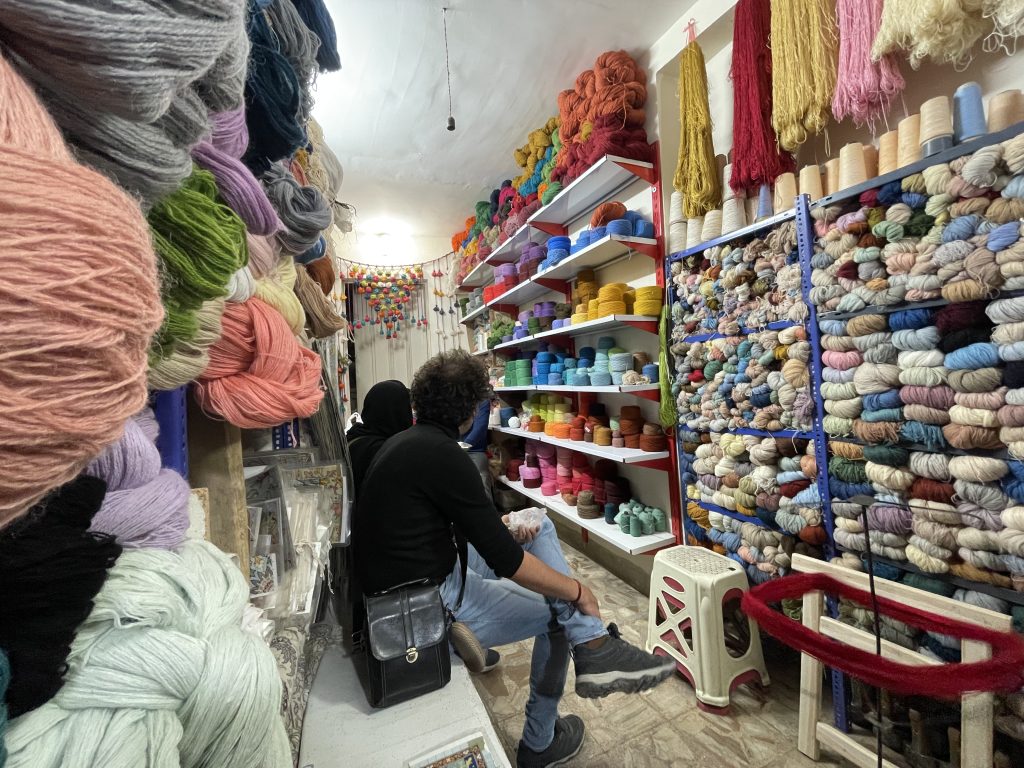
集市里卖色纱的地方
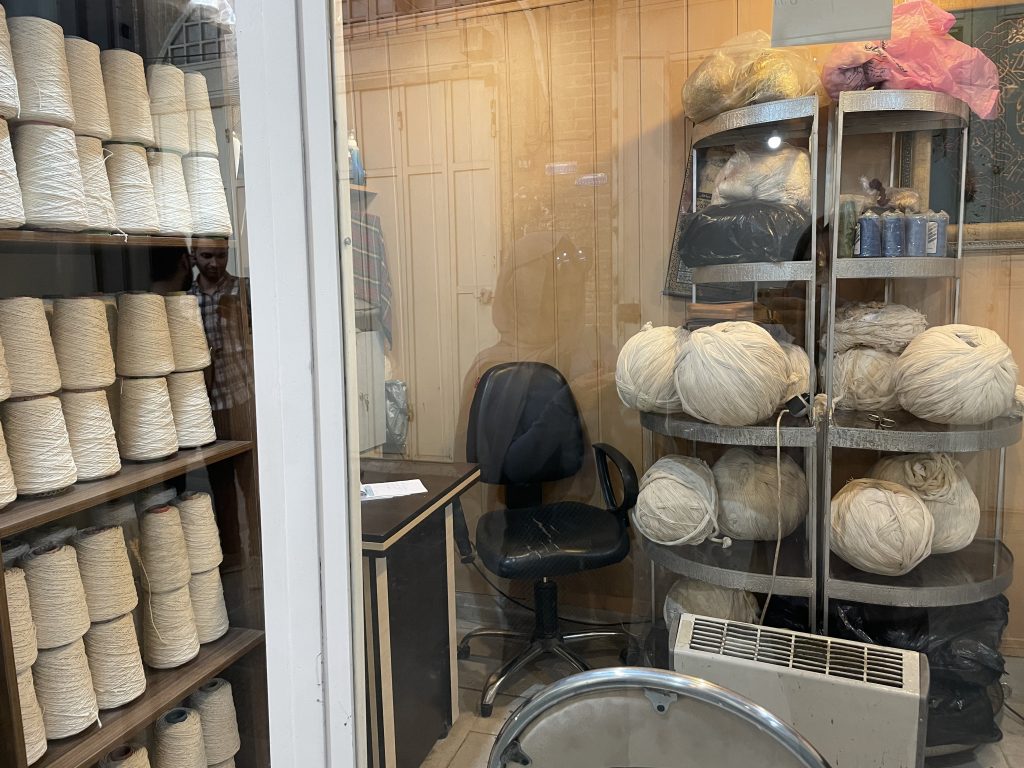
集市里卖原纱的地方
Finally, we went to the carpet shop. The shopper gave us an English introduction about Persian carpets with typical samples, each of which is a unique handmade one in the world. His introduction was mainly about the art styles and pattern meanings. I asked some questions about materials according to my professional interests. He answered all with generosity and patience.
最后,我们终于来到了地毯店,店员用英文向我们介绍了波斯地毯。他一边讲解一边拿出典型样品向我们展示,每一块都是世界上独一无二的手工毯。店员的介绍主要落在艺术风格和图案的含义上,而我根据个人专业兴趣问了一些材料方面的问题,他也都慷慨并耐心地解答了。
As was introduced, there are two main styles of Persian carpets: nomad ones and classical ones. Nomad carpets appeared earlier and classical ones later. Nomad ones are with coarse patterns from natural elements like plants, animals and weather, usually made with wool. While classical ones are with finer and more complicated patterns from religious symbols, more made with silk.
据介绍,波斯地毯主要有两种风格类型:游牧风和古典风。游牧地毯早于古典地毯出现,它们的图案相对比较简单粗糙,来自植物、动物或天气等自然界元素, 通常由羊毛制作;而古典地毯有着更为精细和复杂的带有宗教象征的图案,更多使用蚕丝制作。
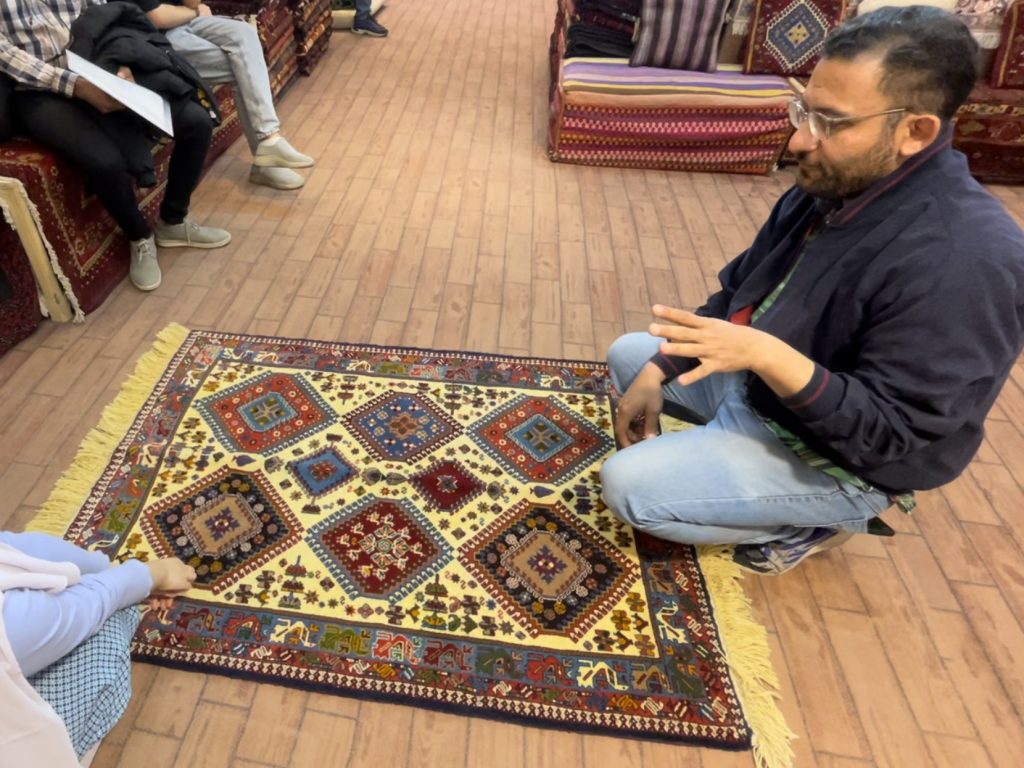
游牧风波斯地毯介绍
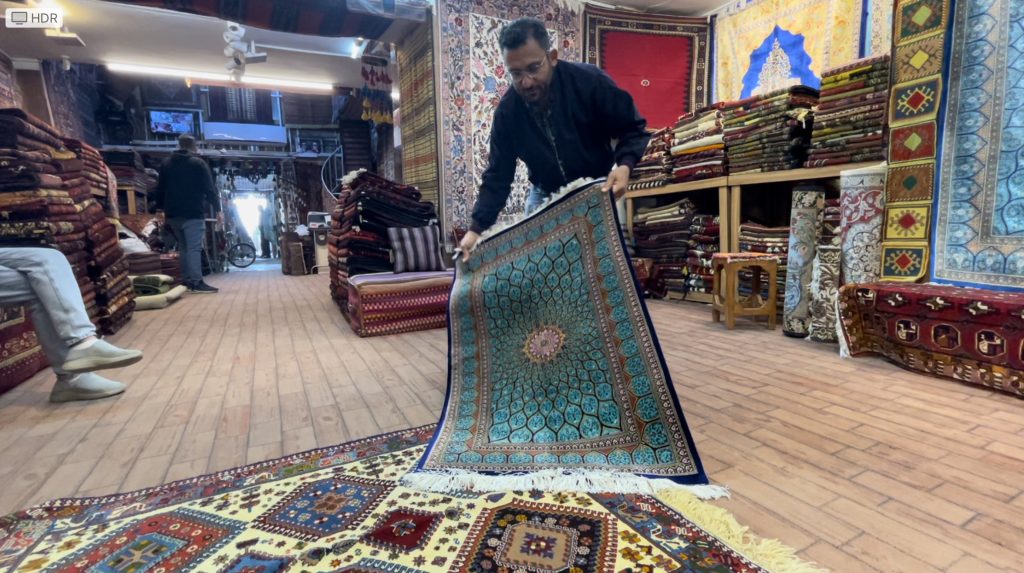
古典风波斯地毯介绍
I think most of the Persian carpets we could see in books, documentaries or shops are in classical style. Maybe this is the most typical and famous style of Persian carpets because they are finer and softer with more complicated patterns, which turned out to be luxurious not only because of their delicate outlook and texture but also the need for finer materials, more skilled makers and more time to complete.
我感觉我们能在书上、纪录片里或商店里看到的波斯地毯,大部分都是古典风格。也许这是波斯地毯最典型也最著名的风格,因为它们更为精细、柔软,图案也更复杂。它们变得高档而奢侈,不仅是因为它们精致的外观与手感,也因为要制作它们,需要更精细的材料、更熟练的工匠以及更多的时间。
The most valuable Persian carpets are all handmade in pure silk with piled technique, each of which will have the maker’s name near the bottom, sometimes with the producing place. Silk carpets distinguish from wool or cotton ones not only because of their fineness but also of their special shining effect. If you turned a silk carpet around or saw them from different angles, it would show different lightness and darkness even different colours.
最有价值的波斯地毯都是纯手工栽绒丝毯,每一件靠近底边的位置都会织入制作者的名字,有时候还有产地名。丝毯区别于羊毛或棉质地毯,不仅体现在它们的精细度上,还体现在它们特殊的光泽效应里。如果你将丝毯旋转一下,或从不同角度观赏它们,它们会呈现出不同的明暗效果,甚至不同的色彩。
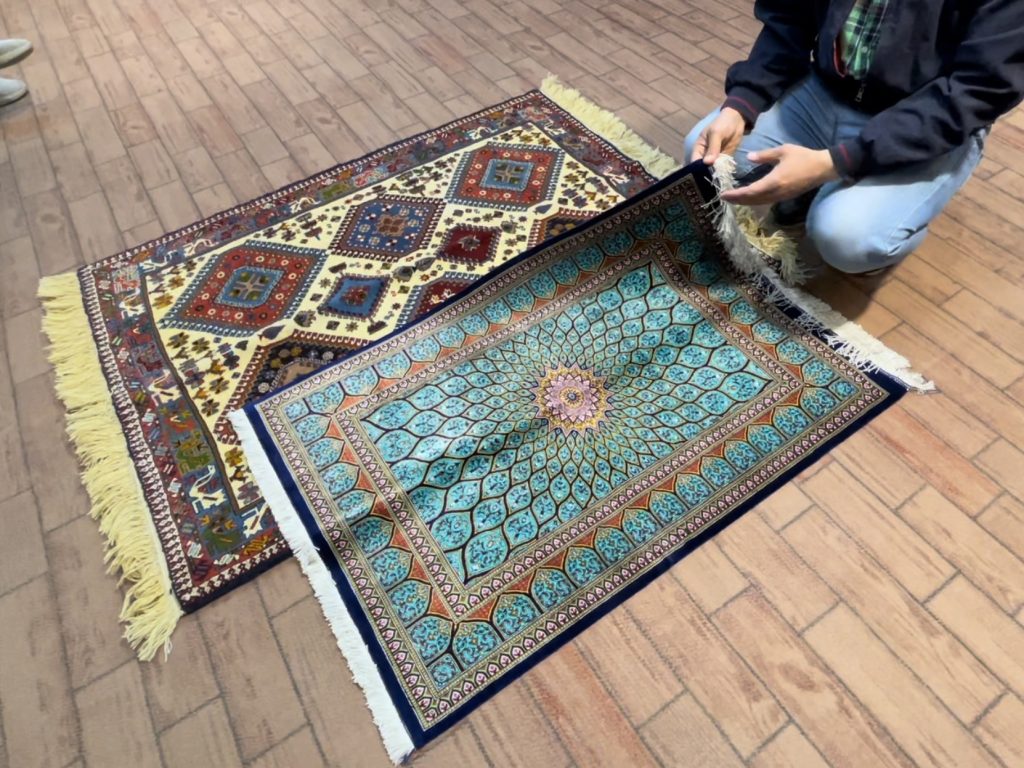
丝毯光泽效应展示
From my knowledge about silk fibre morphology, combing with silk threads arrangement on the piled carpet, I think it is because we see through the longitudinal surface of fibres at one side and cross sections of them at the other side. As a kind of fibre with a triangle cross-section and smooth surface, silk also refracted light into different colours, thus showing different lustres.
以我对蚕丝形态的了解,结合丝线在栽绒地毯中的排列形式,我认为这是由于我们从丝毯的一侧去看时,看到的是纤维纵面,而从另一侧去看时,看到的是纤维截面。而蚕丝作为一种近三角截面的表面光滑的纤维,会将光折射出不同的颜色,继而呈现出不同的光泽。
Outside Iran, we can also see carpets in Persian style, many of which are manufactured with chemical fibres and low prices. Real Persian carpets are all made with natural fibres including cotton, wool and silk. Wool and silk ones are more common while pure silk ones tend to be the most famous and expensive. And handmade ones are more valuable than manufactured ones.
伊朗以外,我们也能看到波斯风格的地毯,许多是用化学纤维批量生产,价格低廉。真正的波斯地毯都是用天然纤维制作,包括棉纤维、羊毛和蚕丝,其中羊毛和蚕丝做的更为常见,而纯丝制作的最有名,也最昂贵。而且,手工制作的地毯会比机器生产的更有价值。
I asked whether their silk threads were produced themselves or imported from other countries like China. They told me there are silk reeling industries in some parts of Iran and they rear silkworms and produce silk threads themselves. Besides, they have no bast fibres or chemical fibres in this country.
我问他们的蚕丝线是自己生产的还是从其他国家比如中国进口的,他们说伊朗有自己的缫丝产业,自己养蚕制丝。此外,伊朗的纺织材料中没有麻,也没有化学纤维。
When our trip to Iran came to an end, the silk carpet hanging on the wall of Lovere, which I mentioned at the start, suddenly appeared in my mind. The first time I saw it, I hadn’t had enough knowledge to know how famous Persian carpets are and understand why they could stand out from most of the carpets in the world. Now I knew and understood better. And the one collected by the boss of Lovere in Wuxi, woven into a world-famous painting, is of course an artwork more for decorative meaning.
在我们伊朗之旅的尾声,我一开始提过的那块挂在“那美”墙上的丝毯,突然出现在我的记忆中。当年我还没有足够的认知了解波斯地毯的声名,也没有足够的知识理解它们为什么能够在世界上的大多数地毯中脱颖而出。现在我知道了更多,也对它们有了更深入的理解。而无锡“那美”的老板收藏的那块织出了世界名画的丝毯,无疑是一件带有更多装饰意义的艺术品。